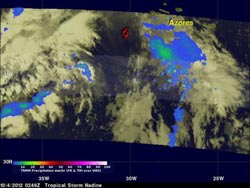NASA notes Nadine now no more

TRMM data on Oct. 3 at 10:49 p.m. EDT showed that Nadine was producing light to moderate rainfall (blue/green) in an area well east of the center of circulation, while the center (red symbol) was rain-free. The approaching cold front that would help bring about Nadine's demise was generating rainfall west of Nadine's center.<br><br>Credit: SSAI/NASA, Hal Pierce<br>
NASA's Tropical Rainfall Measuring Mission (TRMM) satellite passed above long-lasting Nadine for the last time before the tropical storm's dissipation on October 4, 2012 at 0249 UTC (10:49 p.m. EDT October 3, 2012).
TRMM measures rainfall from space and there was very little remaining in Nadine when it passed overhead. Rainfall data from TRMM's Microwave Imager (TMI) and Precipitation Radar (PR) showed that Nadine was producing light to moderate rainfall in an area well east of the center of circulation, while the center was rain-free.
TRMM data showed that the approaching cold front that would help bring about Nadine's demise was generating rainfall west of Nadine's center.
According to NOAA Hurricane Ginger lasted 28 days in the Atlantic Ocean in 1971. In the Pacific Ocean Hurricane John, renamed Typhoon John when it crossed the International Dateline holds the record with a 31 day lifetime during August and September 1994.
Although not the longest-lived tropical cyclone, Nadine is in the top 50 longest-lasting tropical cyclones in either ocean basin.
Media Contact
More Information:
http://www.nasa.govAll latest news from the category: Earth Sciences
Earth Sciences (also referred to as Geosciences), which deals with basic issues surrounding our planet, plays a vital role in the area of energy and raw materials supply.
Earth Sciences comprises subjects such as geology, geography, geological informatics, paleontology, mineralogy, petrography, crystallography, geophysics, geodesy, glaciology, cartography, photogrammetry, meteorology and seismology, early-warning systems, earthquake research and polar research.
Newest articles

Superradiant atoms could push the boundaries of how precisely time can be measured
Superradiant atoms can help us measure time more precisely than ever. In a new study, researchers from the University of Copenhagen present a new method for measuring the time interval,…

Ion thermoelectric conversion devices for near room temperature
The electrode sheet of the thermoelectric device consists of ionic hydrogel, which is sandwiched between the electrodes to form, and the Prussian blue on the electrode undergoes a redox reaction…

Zap Energy achieves 37-million-degree temperatures in a compact device
New publication reports record electron temperatures for a small-scale, sheared-flow-stabilized Z-pinch fusion device. In the nine decades since humans first produced fusion reactions, only a few fusion technologies have demonstrated…





















